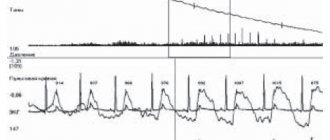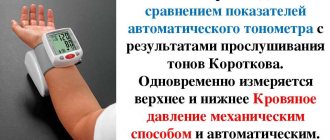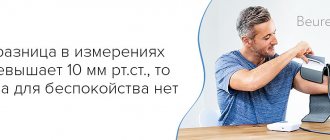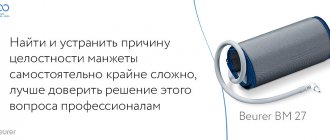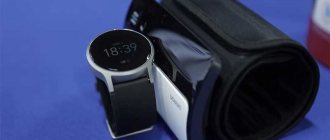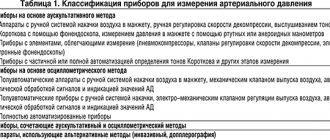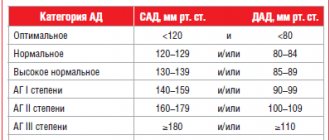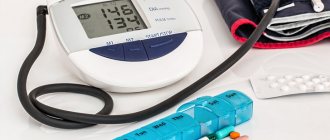What is blood pressure (BP)?
This is the pressure with which blood presses against the wall of the arterial vessel. It consists of 2 numbers: the upper (systolic) is the pressure on the vessel wall at the moment when the heart contracts, and the lower (diastolic) when the aortic valve is closed and the heart relaxes and rests. Systolic pressure is determined by cardiac output, and diastolic pressure depends on how spasmodic or dilated the vessels are, that is, on their tone. Blood pressure up to 140/90 mmHg is considered normal. Anything higher is arterial hypertension, the most common complication of which is stroke or heart attack.
You decided to measure your blood pressure, but it turned out to be elevated. You immediately start taking pills, calling your children or calling an ambulance.
In fact, it may be normal, you just made a mistake when measuring.
First rule . Sit down, lean back in your chair, relax, place your arm bent at the elbow on the armrest or table so that it is at heart level, and place the cuff 2-3 cm above the bend. Tension and anxiety increases blood pressure by 10 mmHg. Under no circumstances should you measure blood pressure while standing or holding your arm suspended.
Secondly , it is not recommended to measure blood pressure through clothing, especially thick clothing. The cuff first compresses the clothing and only then the blood vessels, therefore blood pressure rises. Because of this, its maximum increase can be up to 40 mmHg. The thicker the clothing, the higher the blood pressure.
The third mistake when determining blood pressure is incorrect posture. You sat down, crossed your legs, it’s comfortable for you, but the vessels of the lower extremities are compressed, they narrowed, blood pressure increased by another 8-10 mmHg.
If you made all of the above mistakes, then in total this will add 50-60 mmHg to your true pressure. You think that you have high blood pressure, you are nervous, you take medications that you do not need at the moment, but it is actually normal.
Measurement results and accuracy
- My doctor says that electronic devices are not accurate and that only a doctor and an experienced nurse can measure my blood pressure correctly. How accurate is the result when measuring pressure with a Microlife tonometer?
- When measuring blood pressure with Microlife electronic blood pressure monitors, I expect to get the same result, but every time I get different results. Does this mean that the device is faulty?
- My doctor says my blood pressure is 150 over 100 mmHg, then why does the Microlife device give me a result of 135 over 95 mmHg?
- I understand that the pressure changes throughout the day and therefore I get different results. How can I find out my real blood pressure in this case?
- Before I bought the Microlife tonometer, I used a tonometer from another manufacturer. Why do I get different results when measuring blood pressure with the Microlife device?
- How do I know if the device's readings are accurate after using it for a long time or if it has been dropped?
- Why and when should I test my instrument for accuracy?
- Which tonometer is more accurate - wrist or shoulder?
- I have a Microlife wrist tonometer and a Microlife shoulder tonometer. Why are their readings different?
- Is the accuracy of a manual device comparable to that of an automatic one?
- 11. When measuring pressure with a Microlife tonometer, the systolic pressure coincides with the value determined by the doctor, why the diastolic pressure is 10 mm Hg. higher than determined by the doctor?
- I take several measurements in a row at home with the Microlife device, why, starting from about the fifth measurement, do I get significantly lower readings?
- Can you be sure that the Microlife device readings are correct when measuring blood pressure during pregnancy?
My doctor says that electronic devices are not accurate and that only a doctor and an experienced nurse can measure my blood pressure correctly. How accurate is the result when measuring pressure with a Microlife tonometer?
- Microlife electronic blood pressure monitors measure blood pressure using the so-called oscillometric method. This method has been internationally recognized for more than thirty years and is widely used in medical institutions when it is necessary to determine blood pressure levels with high accuracy. The pressure oscillogram analyzed using this method during deflation of the cuff provides the most accurate results.
- Microlife has been involved in human body signal research and accurate blood pressure measurement for many years. The correctness of the chosen technique is confirmed by independent clinical studies conducted according to international standards.
- It should be noted that the high accuracy of measurements with electronic devices is guaranteed by the fact that they make it possible to carry out measurements at home, when the patient is in a calm and relaxed state.
- Most doctors and nurses, of course, prefer a stethoscope because this method gives them the ability to hear the body's signals and gain deeper insight into their patient's health. But electronic tonometers eliminate situations where doctors are uncertain about the correctness of the results, which arises in cases where they are unable to clearly trace the body’s signals.
- “Medical measurement” of pressure not only includes the human factor, but also does not allow the patient, who is in an unusual environment, to completely relax.
- It is known that the deflation of air from the cuff should occur at a slow pace, at a speed of 2 mm Hg. Art. per second. This is a necessary condition for obtaining accurate results during medical measurements. But this condition is often violated because doctors and nurses use high air deflation rates, which leads to inaccurate measurement results.
- The most convincing fact speaking in favor of electronic tonometers is the recommendations of the most authoritative experts in the field of blood pressure, who call for regular measurements at home, and not in the doctor’s office, since such measurements are only occasional.
- Electronic tonometers provide the opportunity for frequent measurements, they are simple and very convenient. There is nothing special about the fact that the magnitude of the measurement results is different. If a doctor took measurements several times in a row - which, however, he never does - then the results of his measurements would also be different.
When measuring blood pressure with Microlife electronic blood pressure monitors, I expect to get the same result, but every time I get different results. Does this mean that the device is faulty?
- Blood pressure levels are not constant. For various physiological reasons, readings may fluctuate by +/- 30 mmHg over a very short period of time. Therefore, measurement values can vary from one measurement to another. It is practically impossible to maintain the same measurement conditions for each individual sequential measurement. Naturally, different values are obtained due to the instability of the psychological state and external factors (conversations, noise, movement, etc.)
- Therefore, in order to find out your blood pressure level, it is necessary to determine the average value of several measurements that need to be taken over several days, in the same environment, at the same time of day. Try to measure your blood pressure three days in a row, for example, an hour after dinner, and you will see that the difference in the measurement values will be insignificant. The average of these measurements best reflects your blood pressure levels.
My doctor says my blood pressure is 150 over 100 mmHg, why does the Microlife device give me a result of 135 over 95 mmHg?
- You may feel less relaxed in the doctor's office than at home. When you are nervous, your blood pressure rises. In a calm environment, systolic pressure decreases by 15 mmHg. Art., which is normal.
- Blood pressure levels fluctuate throughout the day. Pressure change within +/-30 mm Hg. Art. occur over even a short period of time, in connection with various activities (sports, mental activity, due to stress, abdominal pain, etc.).
- We recommend measuring your blood pressure at the same time of day, in the same environment, for example, every evening, an hour after dinner.
- Each manufacturer differs from the other in its methodology for identifying blood pressure. The “methodology” of the measuring device and the doctor also differ. This difference is comparable to the situation when two doctors, using each stethoscope, measure the pressure of the same patient, but get different values.
I understand that the pressure changes throughout the day and therefore I get different results. But how can I find out my real pressure in this case?
- The average value of several measurements taken several days in a row, in the same environment, at the same time of day, is an individual indicator of blood pressure.
- Try to measure your blood pressure three days in a row, for example, an hour after dinner, and you will see that the difference in the measurement values will be insignificant. The average of these measurements best reflects your blood pressure levels.
Before I bought the Microlife tonometer, I used a tonometer from another manufacturer. Why do I get different results when measuring blood pressure with the Microlife device?
- Most electronic tonometers operate using the so-called oscillometric measurement method. Each manufacturer adheres to its own methods for analyzing signals and determining the values of systolic and diastolic pressure. Significant differences in instrument accuracy have been demonstrated in a number of clinical trials.
- Microlife has been involved in human body signal research and accurate blood pressure measurement for many years. The correctness of the chosen technique is confirmed by independent clinical studies conducted according to international standards.
- Each manufacturer uses its own methodology, which is subsequently optimized for the “standard” population. There may be categories of people for whom one device is better suited than another; similarly, two doctors with different skills in using stethoscopes may obtain different measurement results.
- Another reason for differences in readings is changes in pressure between measurements. It is practically impossible to maintain the same measurement conditions for several successive measurements. Naturally, different values are obtained due to the instability of the psychological state and external factors (conversations, noise, movement, etc.)
- To compare two measurement techniques, it is necessary to exclude the influence of any external factors. The measurement must be carried out in the complete absence of external stimuli, and in strict accordance with the manufacturer's instructions. Each subsequent measurement should take place in a similar environment and at the same time of day. Rest between measurements is required, the interval should be at least 3 minutes. Take several measurements with each instrument and compare the average measurements. Only by strictly following the above instructions can you find out the magnitude of the differences between devices from different manufacturers.
How do I know if the device's readings are accurate after using it for a long time or if it has been dropped?
- If the device works after being dropped, it continues to show correct results. The main components that determine the accuracy of the readings are the electrical circuit board and pressure sensor, which may not work after a strong fall. The remaining parts of the device, such as the release valve or the compressor, are reliably protected from any damage during falls or from wear. Therefore, if such situations arise, we recommend contacting a service center to check the accuracy of the device.
- In any case, in accordance with international standards, we recommend testing your device for accuracy every two years. To do this, contact Microlife service centers.
Why and when should I test my instrument for accuracy?
- Microlife instruments are designed in such a way that their accuracy is maintained over a long service life. To guarantee this accuracy, we recommend - in accordance with international standards - to have the instrument's accuracy checked every two years by an authorized Microlife representative.
Which tonometer is more accurate - wrist or shoulder?
- Both models have comparable accuracy. However, each person has his own structural features of blood vessels and tissues, and therefore each of these devices has its own advantages for different types of people.
- It also happens that for some people the signals on the wrist are very weak, so when measuring pressure with wrist devices, the error signal “Error“ may be displayed.
- Wrist pressure measurements are very sensitive to body movements. Therefore, we recommend that you do not move your hand during measurement.
- It is important that the cuff is at heart level during measurement. For wrist tonometers, this is a common mistake that leads to inaccurate results. Even 10 cm above the level of the heart leads to a result that is 8 mm Hg lower. Art., and 10 cm below the level of the heart - to a result greater by 8 mm Hg. Art.
- Measuring pressure with wrist devices is much easier and faster than with shoulder tonometers, so they are carried out much more often. Because blood pressure varies throughout the day, it is important to take as many measurements as possible. Wrist tonometers allow you to measure blood pressure on the road and in any other conditions where it is difficult to use a brachial tonometer.
- Wrist blood pressure monitors are not recommended for people with severe atherosclerosis. With age, the ligamentous apparatus in the wrist becomes denser, which makes it difficult to obtain a reliable result (the level of blood pressure measured at the wrist will be lower than at the brachial level).
I have a Microlife wrist tonometer and a Microlife shoulder tonometer. Why are their readings different?
- Both models have comparable accuracy. However, each person has his own structural features of blood vessels and tissues, and therefore, for different types of people, each type of device has its own advantages.
- It is very important that the cuff is positioned at heart level when taking measurements. It is quite difficult to comply with this condition when measuring pressure with wrist devices. Even 10 cm above the level of the heart leads to a result that is 8 mm Hg lower. Art., and 10 cm below the level of the heart - to a result greater by 8 mm Hg. Art.
- Some people have very weak wrist signals, so an error signal is displayed very often when taking measurements.
- It is possible to reliably assess your blood pressure using a wrist tonometer by taking into account the difference in indicators with a brachial tonometer.
- If you are measuring the pressure on your wrist, you must follow all instructions very strictly and do not move during the measurement, as the devices are very sensitive to movement.
- Since there are many individual factors, it is recommended to compare two models and choose the one that gives the most consistent results. If you get completely different measurements, we recommend using the shoulder model.
Is the accuracy of a manual device comparable to that of an automatic one?
- Both systems have the same accuracy. Automatic blood pressure monitors have a built-in electric pump, while manual ones have a bulb for inflating the cuff, but this does not affect the accuracy.
When measuring pressure with a Microlife tonometer, the systolic pressure coincides with the value determined by the doctor, which is why the diastolic pressure is 10 mm Hg. higher than determined by the doctor?
- Diastolic pressure is very difficult to determine using a stethoscope and the accuracy of the determination depends only on the ability of the doctor. Correlating diastolic pressure is more difficult than systolic pressure.
I take several measurements in a row at home with the Microlife device, why, starting from about the fifth measurement, do I get significantly lower readings?
- The reason is blood stagnation resulting from too short intervals between measurements. It is also strongly recommended to remove the cuff between measurements.
Can you be sure that the Microlife device readings are correct when measuring blood pressure during pregnancy?
- Yes, Microlife devices have received the necessary certification for measuring blood pressure during pregnancy and preeclampsia. About 20% of women have high blood pressure during pregnancy, which can have a negative effect on the fetus and cause a condition called eclampsia. Therefore, if your blood pressure increases during pregnancy, you should consult a doctor.
How to measure blood pressure correctly?
Do not forget that the pressure must be measured silently , without talking, while in a calm state, since when talking, the muscles tense, their tone increases and blood pressure also becomes higher by 15 mmHg.
It is impossible to measure pressure with a full bladder, since blood pressure rises when holding urine. After going to the toilet - minus 15 mmHg. We also need to remember that when we are in a cold room, we add BP + 20 mmHg to the normal numbers.
Therefore, before you are going to measure your blood pressure, so that the numbers are objective, just go to the toilet, sit in a warm room, relax, lower your legs, roll up your sleeve and then your blood pressure will not be higher than 140/90 mmHg.
Taking care of your health,
